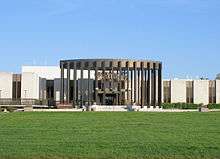Supermicro
Super Micro Computer, Inc, doing business as Supermicro, is an information technology company based in San Jose, California. Supermicro's headquarters are located in Silicon Valley, with a manufacturing space in the Netherlands and a Science and Technology Park in Taiwan.
 | |
| Supermicro | |
| Public | |
| Traded as | NASDAQ: SMCI |
| Industry | Information technology, |
| Founded | 1993 |
| Founders |
|
| Headquarters | , |
Key people |
|
| Revenue | |
| Website | www.supermicro.com |
Founded by Charles Liang, Wally Liaw and Sara Liu on November 1, 1993, Supermicro specializes in servers, storage, blades, rack solutions, networking devices, server management software and high-end workstations for data center, cloud computing, enterprise IT, big data, high performance computing (HPC), and embedded markets.[1][2][3]
In 2016, the company deployed thousands of servers into a single data center[4] and was ranked the 18th fastest growing company on Fortune Magazine’s Top 100 list of the world’s largest US publicly traded companies in 2016 and the fastest growing IT infrastructure company.
History

In September 2014, Supermicro moved its corporate headquarters to the former Mercury News headquarters in North San Jose, California along Interstate 880, naming the campus Supermicro Green Computing Park. In 2017, the company completed a new 182,000 square-foot manufacturing building on the campus.[5][6] The main building was designed by Warren B. Heid in the modernist style, which was common for commercial buildings in the 1960s, and built by the Carl N. Swenson Company. During the time it served as the Mercury News's headquarters, the main building was expanded from 185,000-square-foot (17,200 m2) to 312,000 square feet (29,000 m2).[7] Until recently, a bronze sculpture, Chandelier by John Jagger, hung from the ceiling of an elliptical loggia at the entrance. The loggia is distinguished by a series of metal columns and the moat that surrounds it.[8][9]
Allegations of compromised hardware
On October 4, 2018, Bloomberg Businessweek published a report, citing unnamed corporate and governmental sources, which claimed that the Chinese People's Liberation Army had forced Supermicro's Chinese sub-contractors to add microchips with hardware backdoors to its servers. The report claimed that the compromised servers had been sold to U.S. government divisions (including the CIA and Department of Defense) and contractors and at least 30 commercial clients (including Apple).[10] The backdoor was reportedly discovered by Amazon during a review of Elemental Technologies, a Supermicro client that Amazon would acquire in 2015.[10][11][12]
Supermicro denied the report, stating that they had not been contacted by government agencies and were unaware of any investigation. Amazon and Apple also denied the Bloomberg claims, and the article has faced skepticism over its validity.[13][11][14] One of its named sources stated that the attack detailed seemed theoretical and that he "couldn't rationalize in [his] head that this is the approach that anyone could take."[15] FBI director Christopher A. Wray, in testimony before the U.S. Senate Homeland Security and Governmental Affairs Committee, commented, "Be careful what you read."[16] On October 22 Supermicro announced that "despite the lack of any proof that a malicious hardware chip exists" it was reviewing its motherboards for potential spy chips in response to the article.[17]
On October 9, 2018, Bloomberg issued a second report, alleging that Supermicro-manufactured datacenter servers of an unnamed U.S. telecom firm had been compromised by a hardware implant on an Ethernet connector. The report cited former Israel intelligence officer Yossi Appleboum, who had analyzed and documented the implant. The Bloomberg report did not connect these findings to the previous report.[18][19] Appleboum has since said that his company had found such implants "...in different vendors, not just Supermicro..."[20]
Supermicro filed a letter with the Securities and Exchange Commission stating that it was "confident" that "no malicious hardware chip had been implanted" during the manufacture of its motherboards. It was also reported that the chief executives of Apple and Amazon Web Services rejected claims about the reports regarding hardware backdoors in Supermicro servers.[21]
Environmental responsibility
In 2014 the GCIC Center Tokyo Institute of Technology’s TSUBAME-KFC supercomputer, from Supermicro, was ranked first on the Green 500 list.[22]
The company's newly-constructed manufacturing facility in San Jose was designed to meet LEED gold certification.[5]
References
- Vance, Ashlee (November 23, 2008). "Super Micro Computer: A One-Man, or at Least One-Family, Powerhouse". New York Times. Retrieved September 2, 2017.
- Bailey, Brandon (October 15, 2010). "Charles Liang, founder, Super Micro Computer". Mercury News. Retrieved September 2, 2017.
- Morgan, Timothy Prickett (September 12, 2017). "Surfing On Tech Waves With Supermicro". The Next Platform. Retrieved September 2, 2017.
- Moss, Sebastian (February 7, 2017). "Supermicro puts 30,000+ blades in [Intel's] PUE 1.06 data center". datacenterdynamics.com. Retrieved September 2, 2017.
- Staff, BF (March 8, 2017). "Supermicro Expands Silicon Valley Manufacturing HQ". Business Facilities. Retrieved October 12, 2017.
- "Super Micro opens 182000 square foot expansion near San Jose HQ". Silicon Valley Business Journal. Retrieved October 5, 2018.
- "History of 750 Ridder Park Drive". 750 Ridder Park Drive. History San José.
- "The Loggia Pendant". 750 Ridder Park Drive. History San José. Retrieved June 18, 2018.
- Pizarro, Sal (September 26, 2014). "Pizarro: A bittersweet farewell to the old Mercury News building". San Jose Mercury News. Bay Area News Group.
- Robertson, Jordan; Riley, Michael (October 4, 2018). "The Big Hack: How China Used a Tiny Chip to Infiltrate U.S. Companies". Bloomberg Businessweek. Archived from the original on October 4, 2018.
- Osborne, Charlie. "Apple, Amazon deny claims Chinese spies implanted backdoor chips in company hardware: report". ZDNet. Retrieved October 4, 2018.
- "Chinese spies reportedly inserted microchips into servers used by Apple, Amazon, and others". The Verge. Retrieved October 4, 2018.
- "The Big Hack: Statements From Amazon, Apple, Supermicro, and the Chinese Government". Bloomberg News. October 4, 2018. Retrieved October 4, 2018.
- "Bloomberg stands by Chinese chip story as Apple, Amazon ratchet up denials". Ars Technica. Retrieved October 7, 2018.
- Osborne, Charlie. "Security researcher source in Supermicro chip hack report casts doubt on story". ZDNet. Retrieved October 9, 2018.
- https://www.cnbc.com/2018/10/10/fbi-director-wray-on-super-micro-servers-be-careful-what-you-read.html
- "Supermicro says it's hunting for Chinese spy chips on motherboards". South China Morning Post. October 23, 2018. Retrieved October 23, 2018.
- "New evidence of hacked Supermicro hardware found in U.S. telecom". www.bloomberg.com. Retrieved October 9, 2018.
- "A new twist in Bloomberg's 'spy chip' report implicates U.S. telecom". TechCrunch. Retrieved October 9, 2018.
- Kennedy, Patrick (October 9, 2018). "Yossi Appleboum on How Bloomberg is Positioning His Research Against Supermicro". STH. Retrieved October 11, 2018.
- Prang, Allison (October 22, 2018). "Super Micro Computer Denies Malicious Chip Report, Says It Is Conducting Review Anyway". Wall Street Journal. ISSN 0099-9660. Retrieved October 24, 2018.
- "Supermicro Supercomputer Ranked #1 in Green500". Tom's IT Pro. December 4, 2013. Retrieved October 12, 2017.